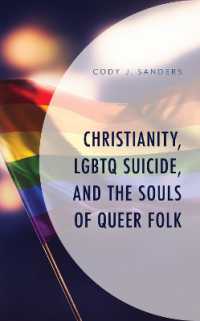Full Description
Shape is a concept widely used in talk about music. Musicians in classical, popular, jazz and world musics use it to help them rehearse, teach and think about what they do. Yet why is a word that seems to require something to see or to touch so useful to describe something that sounds?
Music and Shape examines numerous aspects of this surprisingly close relationship, with contributions from scholars and musicians, artists, dancers, filmmakers, and synaesthetes. The main chapters are provided by leading scholars from music psychology, music analysis, music therapy, dance, classical, jazz and popular music who examine how shape makes sense in music from their varied points of view. Here we see shape providing a key notion for the teaching and practice of performance nuance or prosody; as a way of making relationships between sound and body movement; as a link between improvisational as well as compositional design and listener response, and between notation, sound and cognition; and as a unimodal quality linked to vitality affects. Reflections from practitioners, between the chapters, offer complementary insights, embracing musical form, performance and composition styles, body movement, rhythm, harmony, timbre, narrative, emotions and feelings, and beginnings and endings.
Music and Shape opens up new perspectives on musical performance, music psychology and music analysis, making explicit and open to investigation a vital factor in musical thinking and experience previously viewed merely as a metaphor.
Contents
Contents
List of Contributors
About the Companion Website
Introduction: The malleability of shape - Daniel Leech-Wilkinson and Helen M. Prior
Section I: Shapes mapped
1. Reflection - Evelyn Glennie
2. Postures, trajectories and sonic shapes - Rolf Inge Godøy
3. Reflection - Lucia D'Errico
4. Shape, drawing and gesture: empirical studies of cross-modality - Mats Küssner
5. Reflection - Anna Meredith
6. Cross-modal correspondences and affect in a Schubert song - Renee Timmers and Zohar Eitan
Section II: Shapes composed
7. Reflection - George Benjamin
8. Shapes of affect in Bach's Sonata in G minor for Unaccompanied Violin - Michael Spitzer
9. Reflection - Steven Isserlis
10. Shape in music notation: exploring the cross-modal representation of sound in the visual domain using zygonic theory - Adam Ockelford
11. Reflection - Alice Eldridge
12. Shape in improvisation - Milton Mermikides and Eugene Feygelson
Section III: Shapes performed
13. Reflection - Max Baillie
14. Musical shape for performers - Helen M. Prior
15. Reflection - Simon Desbruslais
16. Reflection - Malcolm Bilson
17. Shaping popular music - Alinka Greasley and Helen M. Prior
18. Reflection - Steve Savage
Section IV: Shapes seen
19. Reflection - Mark Applebaum
20. Reflection - I-Uen Hwang
21. Music and shape in synaesthesia - Jamie Ward
22. Reflection - Timothy B. Layden
23. Reflection - Stephen Hough
24. Reflection - Alex Reuben
25. The shape of music in dance - Philip Barnard and Scott deLahunta
26. Reflection - Richard Mitchell
Section V: Shapes felt
27. Reflection - Julia Holter
28. Musical shape and feeling - Daniel Leech-Wilkinson
29. Reflection - David Amram
30. Reflection - Antony Pitts
Index







